Skipwith NNR Pillwort update 2020
21st August 2020
This summer, Anne Carter, our Northern Project Officer, once again teamed up with FHT friend and collaborator Dr Barry Wright to monitor the populations of the rare aquatic fern pillwort (Pilularia globulifera) at Skipwith NNR, one of our Flagship Pond sites in Yorkshire.
Pillwort was once abundant at Skipwith, with a good population present on ‘Pillwort Pond’. But by 2015 none could be found and it was thought to have been lost from the reserve altogether. However in 2017, during FHT’s ‘People, Ponds & Water’ project, a population was discovered on Horseshoe Pond. This kick-started the ‘Yorkshire Pillwort Project’ and in 2018 surveys were carried out by Anne and Barry with help from the Yorkshire Fern Group and local volunteers. The population on Horseshoe Pond was doing well, but surveys of surrounding suitable ponds did not come up with any new populations. In order to secure and strengthen one of the few remaining sites for this rare fern in the Yorkshire lowlands a programme of translocations began.
In 2019, pillwort was translocated into a group of new small shallow ponds, created as part of People, Ponds & Water with pillwort in mind. We decided to call them the Runway Pond cluster because this was the site of an old airfield which had been reclaimed for nature. We also introduced the plant to two other ponds on the site, Concord and Reed: more about those later. Anne and Barry also tried out some new tech in the form of a drone camera to help with future monitoring.
Fast forward to 2020 and armed once again with ‘Roger the Drone’ a pack of blank CD’s and garden canes with toppers, the duo returned to Skipwith to carry out further experiments.
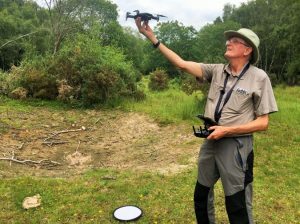
The great news is that the pillwort is doing fantastically well! The pillwort planted in the new Runway pond has expanded substantially and although the pond was dry, the plants were looking lush in parts. There was also evidence of the pills starting to pop in the dryer areas! The sporocarps (‘pills’) are a reproductive structure, situated where the fronds are attached to the rhizome. These become dark and scaly when mature, at which stage they split and, when in water, release the male and female gametophytes and sporangia.
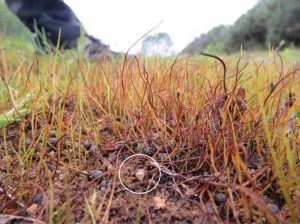
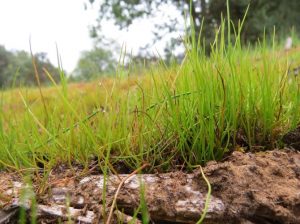
In order to map the pillwort, blank CDs were used to mark the extent of the fern before being photographed using the drone. It was hoped that by using this technique repeat visits in subsequent years will enable us to compare the spread. As this particular pond was dry the garden canes and stoppers didn’t have to be used as these were brought along so that the CD’s could be ‘suspended’ above the water level!
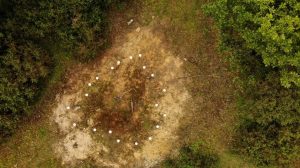
After our first elation at seeing the extent of pillwort on the ‘Runway’ Pond we moved on to Concord, one of the ponds we had earmarked for translocation back in 2018. We did manage to transplant a small amount in 2019 when the water had returned, so we were hoping that it had survived the winter. Once again the pond had dried back considerably so we were happy to find a small amount of pillwort in the same location. We were even happier when, walking around the edge of the pond, we stumbled across a larger patch of pillwort away from the original translocated material. Further investigation around the perimeter of the pond then revealed even more at the opposite end of the pond! Using the CD method we were able to again map this using the drone. Brilliant to know that this pillwort must have established itself, so our hunch that it was a suitable pond was correct.
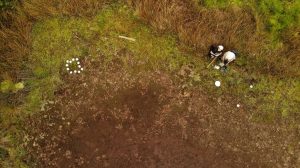
Following this mini triumph, the next pond to visit was Horseshoe where the thriving pillwort population was discovered in 2017. This pond, like Concord, is naturally shallow with a relatively firm base and, again, on this visit the majority of the pond had dried back. We had actually surveyed this pond in early June and mapped the extent of spread then, an increase from 4m2 overall recorded on our very first survey back in October 2017, shortly after it was first discovered, to 35.5m2. This second visit in August 2020 revealed that it had spread even further, working its way out from the bank edge. In fact we also found even more new ‘patches’ of pillwort at different points around the perimeter. This time the figure came out at 76m2, an amazing increase in just a couple of months.
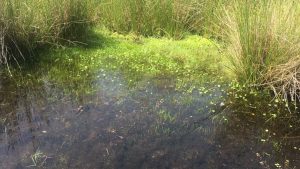
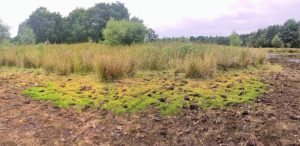
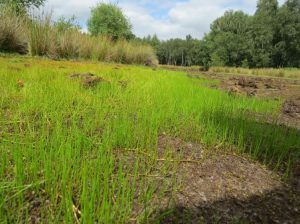

Our final visit of the day was to Reed Pond, where, like Concord, we translocated small amounts of pillwort back in 2019. Sadly the area where we had previously planted it was bone dry and looked like it had been this way for a considerable amount of time. After a prolonged fingertip search we failed to find any evidence of pillwort. Like Concord we also searched the rest of the perimeter of the pond, but to no avail. But fingers crossed: it may turn up at some later date!
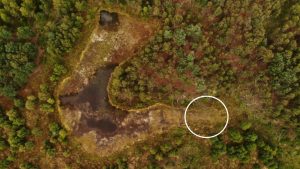
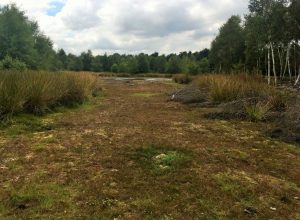
Our thanks go out to Dr Barry Wright for his tireless enthusiasm for pillwort and help with monitoring this rare and fascinating fern.
To find out more click on the links below:
